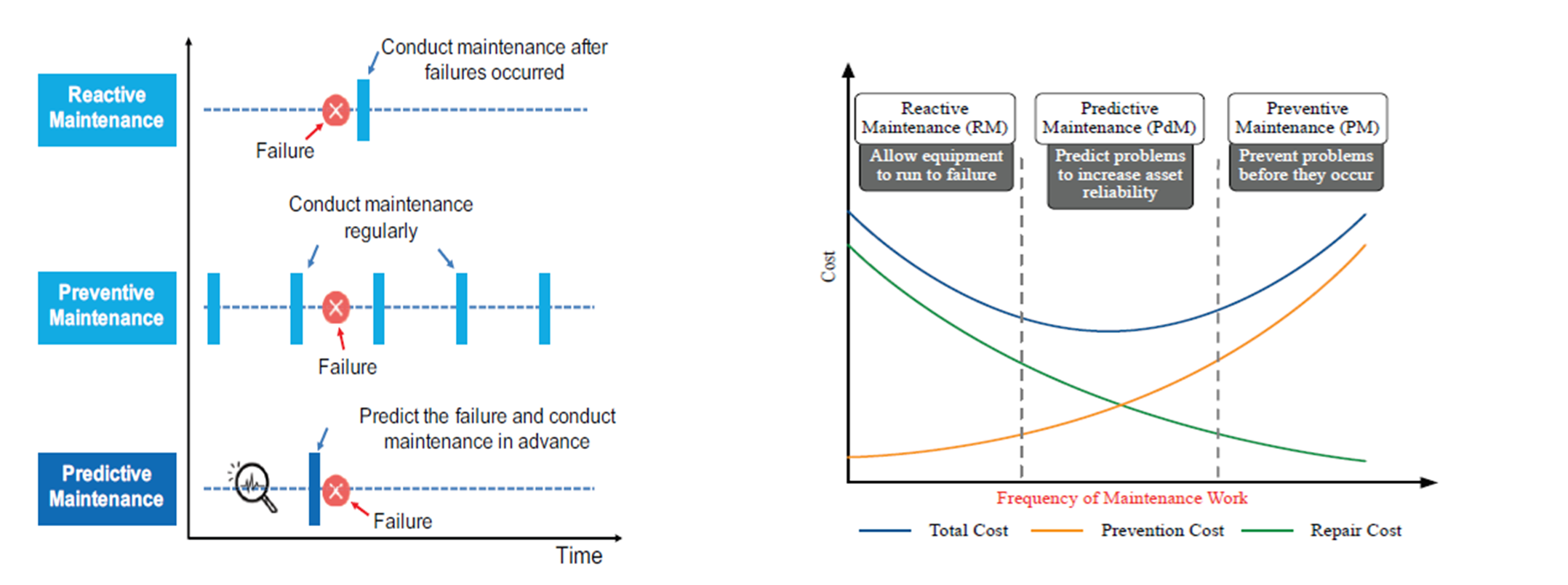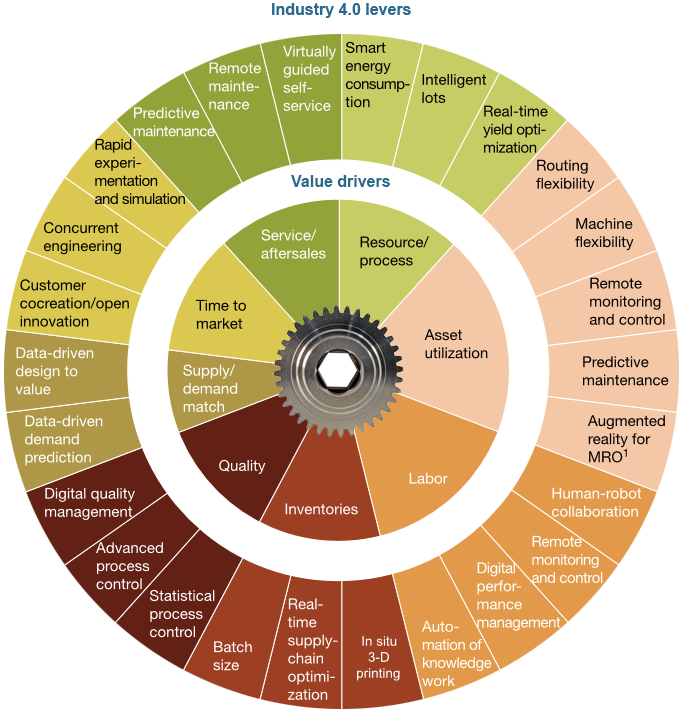Industry 4.0, an ongoing phenomenon in the manufacturing sector, aims to increase the reliability and efficiency of manufacturing processes. This initiative to enable a digital convergence between industry, businesses, and other processes is primarily driven by automation and digitalization. The main driver of this phase is cyber-physical systems with embedded software and control systems connected to the internet. Sensors installed at component levels are connected through cyber-physical systems which are constantly collecting and analyzing data to generate useful insights. Industry 4.0 intends to increase competitiveness among industries, improve processes and reduce risks associated with manufacturing.
Industry 4.0 technologies aim to capture information to increase value. A report by McKinsey Digital, Industry 4.0: How to navigate digitization of the manufacturing sector released in the year 2015 recognizes 8 areas that can be improved by Industry 4.0 technologies. These areas include Asset utilization, Process, Labour, Inventories, Quality, Supply-Demand Match, Time to Market, Services, and Aftersales.
Asset utilization aims at increasing the value of machinery used in the industry. This targets improving the reliability of machines, controlling their planned and unplanned downtime, reducing the capital expenditures associated with operations, and in short, increasing the revenue. Two important technologies in this area are Remote monitoring and Control and Predictive maintenance (PdM) of equipment.
Coupled with the advances in Artificial Intelligence and Machine learning (ML), in particular, PdM is being seen as a one-stop solution to all maintenance-related concerns.
Equipment Maintenance philosophies and practices have evolved with time to meet the demands of the industry. The practices differ according to the type of industry. However, on a broad scale, there are three prevalent maintenance philosophies in the industry.
- Reactive/Breakdown Maintenance: the philosophy here is simple; fix the machine when it fails. This is undoubtedly the most expensive and the least efficient of all maintenance philosophies as it is associated with the high cost of Spare parts and manpower in addition to equipment downtime and overall loss of production. An analysis of expenses indicates that corrective maintenance practices are three times more expensive than timely scheduled maintenance practices.
- Preventive Maintenance: It is a conservative maintenance practice, where maintenance of equipment happens at regular time intervals.
- Predictive Maintenance, by definition, involves constant monitoring of equipment parameters by the physical and/or virtual sensors embedded/installed on the equipment. It uses real-time sensor values to access the condition of the equipment.

Preventive Maintenance cost is the highest for time-based maintenance while Repair cost is the highest for reactive maintenance. It can be noted that both repair cost and prevention cost is the lowest for Predictive Maintenance thereby reducing the total cost of equipment maintenance significantly.
Machine Learning Use Cases in Predictive Maintenance
According to McKinsey & Company, AI-based predictive maintenance can boost availability by up to 20% while reducing inspection costs by 25% and annual maintenance fees by up to 10%.
Machine Learning tasks for PdM methods are used for three objectives: Remaining useful life prediction of machines (regression task), fault diagnosis (classification task), and anomalous behavior prediction in the absence of historical data (Ran et al., 2019).
- Remaining useful life (RUL) estimation – Remaining useful life is an estimate of the number of remaining years that a component in a production line is estimated to be able to function per its intended purpose before warranting replacement.
- Failure Diagnosis and Classification: Given a set of sensor data and failure labels, the model should be able to diagnose the fault.
While classification might be used to determine whether an asset has a defect that can lead to unscheduled downtime, regression would draw on historic behavior plus current data to predict the remaining useful lifetime of the asset and estimated time to failure.
PdM techniques have primarily exploited supervised learning methods in numerous applications and produced noteworthy results. However, supervised learning algorithms necessitate labeled data. Labeled data in industrial setups is a formidable challenge and not readily available. This presents an opportunity to tap the potential of unsupervised learning methods in PdM techniques.
- Anomaly detection: Using unlabeled data, Machine learning is used to detect if and when a parameter deviates from its usual trajectory. The ML model aims to discover unknown patterns in the data, e.g. through similarities between the data points. Anomalies are data points that deviate from the normal expected behavior.
In recent times, anomaly detection is gaining traction to detect aberrations in data points with the intent to predict and prevent failures.
Vibration data is the most explored signal data in PdM techniques followed by acoustic emission, and pressure.
PdM: Potential and Challenges in Adoption
Overall Equipment Effectiveness (OEE) which is indicative of equipment’s availability and reliability is one of the main key parameter indicators (KPIs) in the manufacturing industries. Unforeseen faults and the subsequent downtime often push this parameter to negative values. It is estimated that using PdM in industries can increase these KPIs by greater than 90%.
Apart from the obvious advantage of reducing downtime and cost, the PdM strategy also improves efficiency and overall production. From a maintenance point of view, PdM methods also reduce the stock of spare parts and inventory management as there is a noted reduction in unplanned downtime with PdM methods. From the safety vantage point, the PdM strategy improves operator safety as an early indication of faults or warnings of failure prevents operators from working in unsafe conditions consequently reducing the chances of personal injury or death. PdM is one of the trademarks of evolution in Industry 4.0. Predictive Maintenance is currently a 6.9 billion dollar industry projected to grow up to 28.2 billion dollars in the next 5 years.
Although PdM is being presented as an elixir in the Manufacturing industry and a one-stop solution to all the maintenance-related woes in the industry, its real-time adoption within the industry is still in its nascent stages. Some of the challenges associated with the adoption of PdM techniques include:
- Resource and cost: Shifting to a PdM strategy requires the upgradation of the existing infrastructure.
- Data Quality: Most of the PdM models are developed on data generated from experimental setups and not real-time data.
- The threat of cyber-attacks increases when the industry goes digital.
- The interpretability of models developed using Machine Learning techniques is low.
With the expansion of the Digital Economy, the Manufacturing sector has to adapt and deliver sound and quick results. Industries cannot afford to lose competitive advantage due to unplanned downtimes. However, it should also be noted that no one maintenance strategy is a one-stop solution to all maintenance-related concerns. The future maintenance strategy would be a mixture of different maintenance strategies depending on cost and risk with data at its center.
References:
Balaji, K., Rabiei, M., Suicmez, V., Canbaz, H., Agharzeyva, Z., Tek, S., Bulut, U. and Temizel, C., (2018) Status of data-driven methods and their applications in oil and gas industry. Society of Petroleum Engineers - SPE Europec featured at 80th EAGE Conference and Exhibition 2018.
Myers, D., Suriadi, S., Radke, K. and Foo, E., (2018) Anomaly detection for industrial control systems using process mining. Computers and Security, 78, pp.103–125.
Çinar, Z.M., Nuhu, A.A., Zeeshan, Q., Korhan, O., Asmael, M. and Safaei, B., (2020) Machine learning in predictive maintenance towards sustainable smart manufacturing in industry 4.0. Sustainability (Switzerland), 1219.
Si, X., Wang, W., Hu, C. and Zhou, D., (2011) Remaining useful life estimation – A review on the statistical data-driven approaches. European Journal of Operational Research, [online] 2131, pp.1–14. Available at: http://dx.doi.org/10.1016/j.ejor.2010.11.018.
Ran, Y., Zhou, X., Lin, P., Wen, Y. and Deng, R., (2019) A Survey of Predictive Maintenance: Systems, Purposes and Approaches. [online] XXXx, pp.1–36. Available at: http://arxiv.org/abs/1912.07383.
R. Keith Mobley, (2002) An Introduction to Predictive Maintenance.

